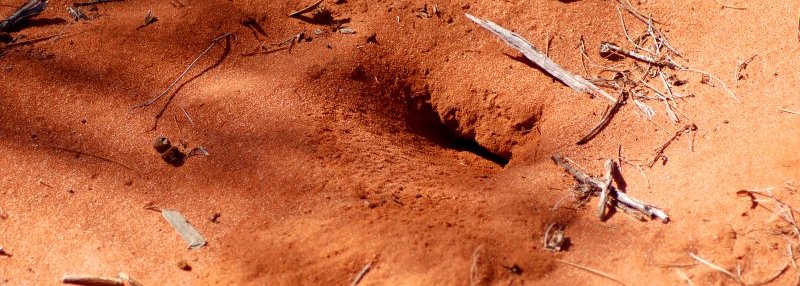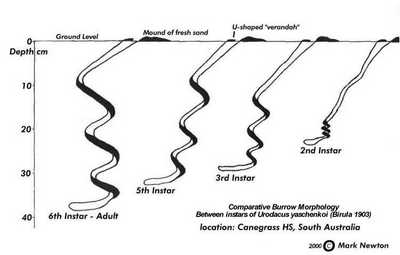
The Burrow Structure of Urodacus yaschenkoi
Burrowing ability allows U.yaschenkoi to successfully inhabit an arid environment.
Survival in a desert environment is difficult for any organism, U. yaschenkoi's successful adaptation to arid conditions has allowed it to attain large population numbers and be one of the most common organisms to inhabit Australia's interior. Found from South Eastern inland Australia, diagonally across the interior to the North West coast. The studies I have conducted on this species were made North of Berri in South Australia and only directly relate to those animals.
U. yaschenkoi almost exclusively inhabits sandy soil country , there are areas where hard soil meets sandy soil and you can stand in the middle and see the species is virtually non-existant in the hard soil area and plentiful within the sandy soil area. It's that clear cut, the vegetation changes from Eucalypts and small shrubs in the sandy soil conditions to predominately Casuarina pines and bluebush in the hard soil areas. Pockets of hard ground occur within the sandy area and vice versa, either way U.yaschenkoi only exploits the sandy soil type, with very few individuals occuring in the harder soil type....seems like a niche just waiting. It would appear as though fitness of the animal is significantly reduced within the harder soil type.
 |
the SPIRAL BURROWThe spiral burrow is a type of burrow constructed by various species of Urodacus and African Opistophthalmus. There have been no conclusions drawn as to the benefits of this morphology however considerations may be, increased difficulty for predator excavation, water vapour entrapment, greater insulation from the surface environment. The image above shows a generalised burrow structure for each of 4 different age instars, adult on the left to youngest on the right. The 5 different instars that dig burrows, instars 2-6, all dig to a deeper depth than the previous instar, and all dig burrows with the same three components, entrance chamber, spiral section and the terminal chamber. |